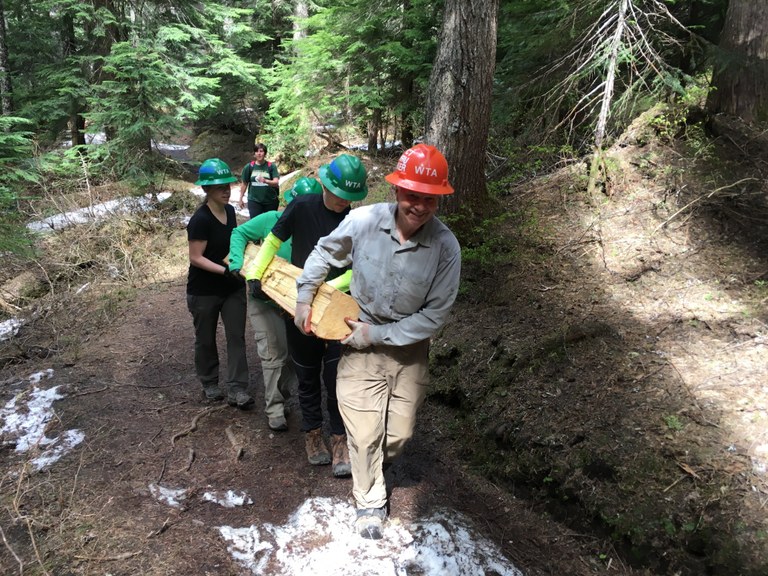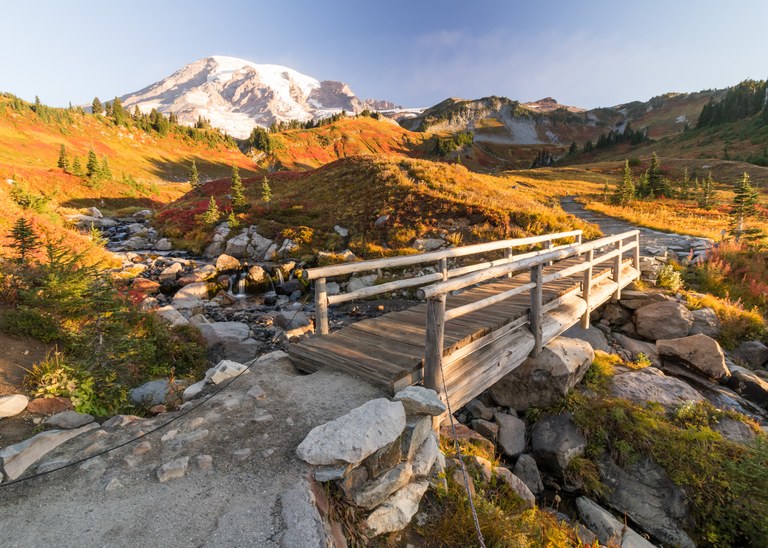What to Expect at Mount Rainier This Summer: Q&A With Rainier's Superintendent
WTA staff recently sat down — over Zoom — with Chip Jenkins, superintendent of Mount Rainier National Park, to gain some behind the scenes insight on what we can expect at the park this year.
By Rebecca Viets
A lot of work goes into preparing a park like Mount Rainier National Park for the summer season — and this year the COVID-19 pandemic has made that work even more complex. WTA staff recently sat down — over Zoom — with Chip Jenkins, superintendent of Mount Rainier National Park, to gain some behind the scenes insight on what we can expect at the park this year. Here’s what he had to say. This Q&A has been edited for clarity and length.

Chip Jenkins, superintendent of Mount Rainier National Park, by Kevin Bacher, NPS.
Washington Trails Association and Mount Rainier National Park have enjoyed 20 years of trail maintenance partnership. What has this helped to accomplish at the park?
While we work with many individuals and organizations to host volunteers, it is unique to work with an organization that has people who are able to do high quality work on a routine basis, and provide their own paid staff to supervise crews of volunteers. WTA is a true force multiplier by helping enable people to come and do work that we otherwise simply wouldn’t be able to get done.
What can hikers expect this summer at the park and what are the behind-the-scenes factors that are influencing what is and is not open at this time?
In a park like Mount Rainier, where we get big winter snow packs and a lot of summer hiking, opening up for the summer is like a chain of dominoes. First we have to remove snow, then get generators and the power working so we can turn on the waste water and sewer treatment systems. Then we need to be able to get the heating systems running and de-winterize buildings before employees can move into housing in March and April. Then we send people out to do assessments on the ground. What’s the condition of the trailhead? How much deadfall is down? Have bridges been damaged? It’s like a small army advancing across the landscape and if you don’t have the logistics in place you can’t support the work going on in the field.

It takes a lot of work to clear fallen trees and debris off trails after a long winter. Here volunteers clean up a trail near Carter Falls. Photo by Hannah Tennent.
This year, we are about eight weeks behind a “normal” schedule. We had 12 weeks go by in the spring where we couldn’t bring on our seasonal employees and in the time of COVID, we can’t put people into high density housing. Using CDC and public health guidance, we’ve had to limit one employee per bedroom, per bathroom and that has effectively cut our summer staff in half. While access is being restored and people can get out, what you're going to find is more trees down along the trail, foot logs might not be in place at river crossings, and some bridges will still need to be inspected for repair. Some of our front country campgrounds haven’t opened yet and the primary reason is that we have to finish doing assessments and mitigation of standing hazard trees that might fall across a campsite. Please practice your patience because this is a really different year.
Working with REI, WTA launched the Recreate Responsibly Coalition consisting of land managers and other outdoor recreation organizations to help our community be outside in a responsible way during the Covid-19 pandemic. What has been the impact of that coalition work in the park?
The impact of that work has been incalculable. In my 30-plus years as a professional with the National Park Service, I don’t know that I have ever seen people across the recreation spectrum from equestrians, hunters, hikers, climbers, ORVs and mountaineers, rally to establish a set of behavioral norms. We have felt and seen it in the park in terms of broad public support, compliance and the way people are behaving.
We have been doing an outstanding job connecting with the recreation community, the people who have some degree of familiarity with where to go to get current and updated information - digital sites like WTA, MRNP’s website, Twitter feed and Facebook page. Our challenges are connecting with the public who are not already seeking this information.
How are trails and infrastructure funded at Mount Rainier National Park and what are some promising things you see on the horizon for trails within the park?
There is an enormous degree of variability in funding structures between different land agencies. For the National Park Service, the vast majority of funding comes to us as federal appropriations, half as money for operating the park and half as project money that all the parks compete for. When we are able to show that we can leverage our funding with other organizations, like WTA, it allows our projects to float up on the funding priority list. On top of that, we have fee funds from entrance passes and lodge stays, plus a smaller portion that comes from private philanthropy. Since 2010 our funding has been flat, but operating expenses go up 3-4.5% each year. Our budgets have not been cut, but our purchase power continues to significantly erode.

WTA has partnered with Mount Rainier National Park for many years to improve its trails. WTA Archive.
The bright spot is that the Senate just passed the Great American Outdoors Act which would fully fund the Land and Water Conservation Fund and provide a substantial amount of funding to the National Park Service. In anticipation of that, we have developed a five year program of proposed projects which would potentially include the complete rebuild of the 15 miles of trail at Paradise so they can be there and ready to use for the next 100 years.
The past month has put an exclamation point on the historical and systemic racism in the United States. We know that there are barriers that lead the BIPOC (Black, Indigenous and People of Color) community to feel less welcome and less safe in the outdoors. What is the park’s thinking on how we create a safe and inclusive space for all?
Mount Rainier National Park stands against racism. We stand for equity, inclusion, justice and freedom for all; that embodies what a national park is supposed to be. All Americans should feel equally welcome and have equal access to come and enjoy their parks. Over the years I have been very focussed on programs and projects that can support diversity, equity and inclusion work — things like working with WTA to host the Latino Outdoors volunteer vacation for a week of trailwork in the park.
In the last five weeks, however, I have been really trying to listen to the voices that are coming out of the Black and Latino communities. I think we need to step back and examine in further detail what is transpiring where people are not feeling welcome and also understanding what welcoming looks like. How do we put those things in place so that people do feel safe, do feel welcome, do have support and the confidence to be able to go to a place they have not visited before and engage in a sense of adventure and exploration? How do we help people feel like the risks that they’re taking are the risks they are assuming themselves, not those that others are putting on them?

Golden Gate Trail at Mount Rainier National Park. Photo by Muhamad Said.
What is your favorite place for a Rainier experience that’s outside of the national park?
It is a Jenkins family tradition that on the first of January, we go for a hike on the Bluff Trail at Ebey’s Landing and when you are out there on a clear January day and you are able to see Mount Rainier, Mount Baker and the Olympics, there’s pretty much not a more spectacular place in the entire Pacific Northwest than right there.


Comments